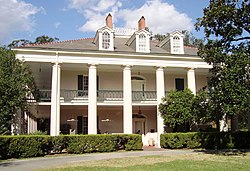Oak Alley Plantation
|
Oak Alley Plantation
|
|

Oak Alley Plantation mansion
|
|
| Nearest city | Vacherie, Louisiana |
|---|---|
| Area | 25 acres (10 ha) |
| Built | 1837 |
| Architect | Joseph Pilié |
| Architectural style | Greek Revival |
| NRHP Reference # | 74002187 |
| Significant dates | |
| Added to NRHP | December 2, 1974 |
| Designated NHL | December 2, 1974 |
Oak Alley Plantation is a historic plantation located on the west bank of the Mississippi River, in the community of Vacherie, St. James Parish, Louisiana, U.S. Oak Alley is named for its distinguishing visual feature, an alley (French allée) or canopied path, created by a double row of southern live oak trees about 800 feet (240 meters) long, planted in the early 18th century — long before the present house was built. The allée or tree avenue runs between the home and the River. The property was designated a National Historic Landmark for its architecture and landscaping, and for the agricultural innovation of grafting pecan trees, performed here in 1846–47 by an enslaved gardener.
The Bon Séjour plantation, as Oak Alley was originally named, was established to grow sugarcane, by Valcour Aime when he purchased the land in 1830. Aime, known as the "King of Sugar," was one of the wealthiest men in the South. In 1836, Valcour Aime exchanged this piece of property with his brother-in-law Jacques Télesphore Roman for a plantation owned by Roman. The following year Jacques Roman began building the present mansion under the oversight of George Swainy and entirely with enslaved labor. The mansion was completed in 1839. Roman's father-in-law, Joseph Pilié, was an architect and probably designed the house.
The most noted slave who lived at Oak Alley Plantation was named Antoine. He was listed as "Antoine, 38, Creole Negro gardener/expert grafter of pecan trees," with a value of $1,000 in the inventory of the estate conducted upon J.T. Roman's death. Antoine was a master of the techniques of grafting, and after trial with several trees, succeeded in the winter of 1846 in producing a variety of pecan that could be cracked with one's bare hands; the shell was so thin it was dubbed the "paper shell" pecan. It was later named the Centennial Variety when entered in competition at the 1876 Centennial Exposition in Philadelphia, where it won a prize. The trees may be found throughout southern Louisiana, where the pecan was once a considerable cash crop. Although Antoine's original trees were cleared for more sugar cane fields after the Civil War, a commercial grove had been planted at nearby Anita Plantation. Unfortunately, the Anita Crevasse (river break) of 1990 washed away Anita Plantation and all remains of the original Centennial pecans.
...
Wikipedia


